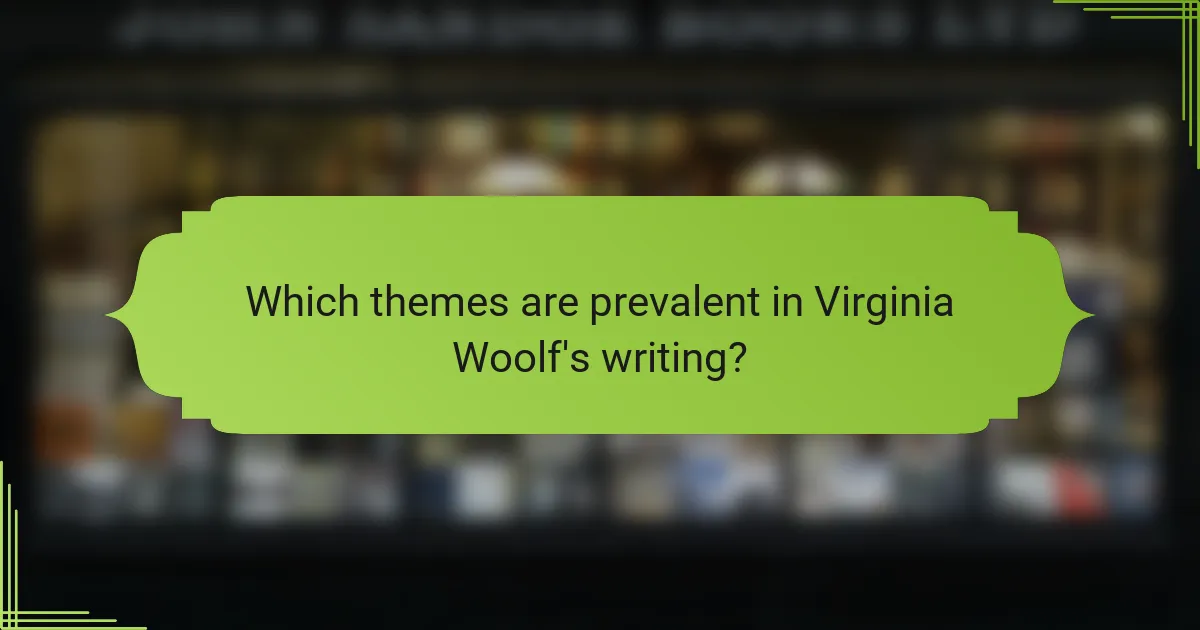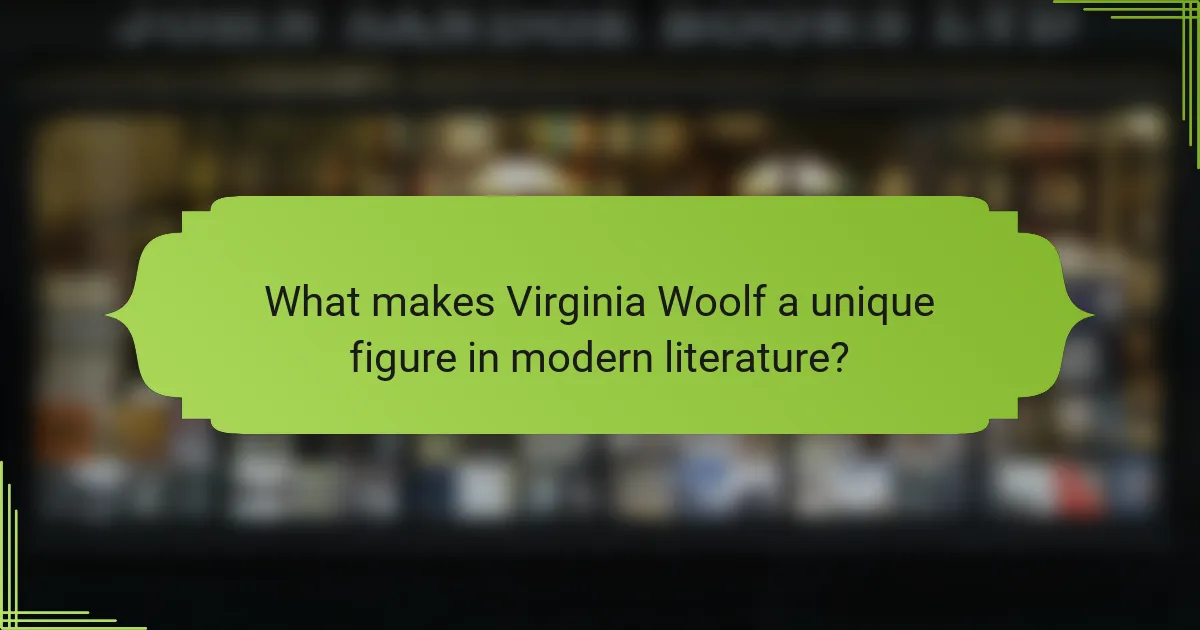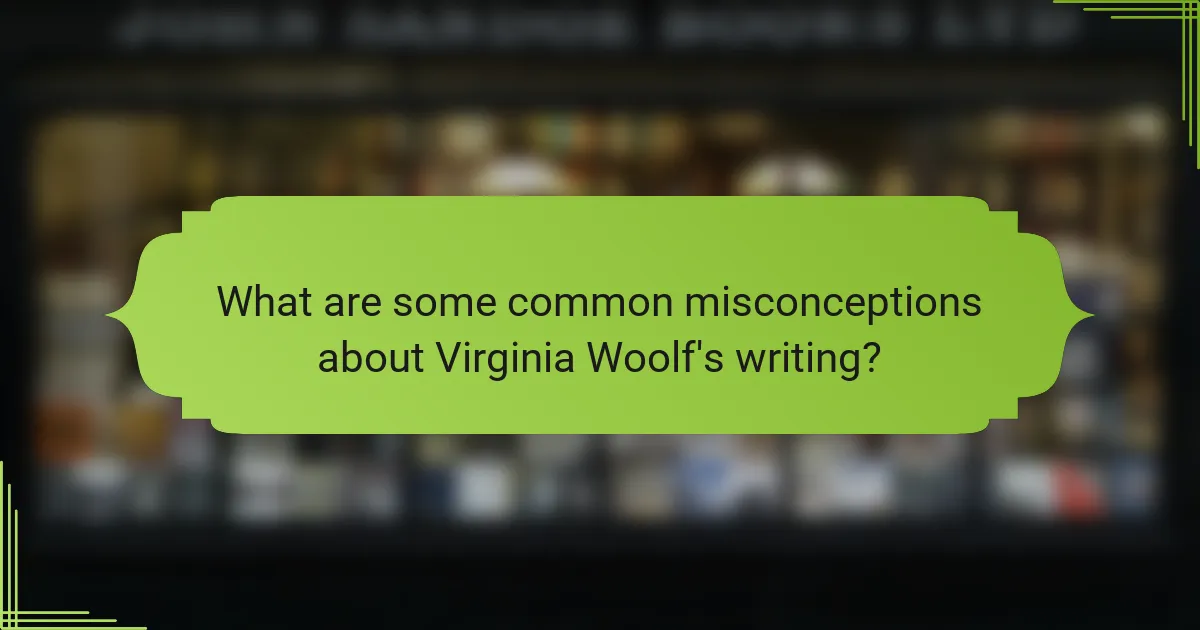Virginia Woolf’s innovative literary techniques significantly shaped modern literature. This article explores her use of stream of consciousness, nonlinear narrative, and vivid imagery. It also examines prominent themes such as gender identity and the passage of time. Finally, we will discuss her lasting impact on contemporary authors and feminist literature.

What are the key literary techniques employed by Virginia Woolf?
Virginia Woolf employs key literary techniques such as stream of consciousness, nonlinear narrative, and vivid imagery. These techniques create deep psychological insight and evoke emotional resonance. Stream of consciousness allows readers to experience characters’ thoughts in real-time, while nonlinear narrative challenges traditional storytelling structures. Woolf’s use of imagery enhances the sensory experience, making themes of time and identity more impactful.
How does stream of consciousness shape her narratives?
Virginia Woolf’s stream of consciousness technique profoundly shapes her narratives by immersing readers in characters’ inner thoughts. This approach enhances emotional depth and portrays the fluidity of human experience. Woolf’s unique ability to blend time and memory creates a rich tapestry of consciousness that reflects modernist themes. For instance, in “Mrs. Dalloway,” the narrative shifts seamlessly between characters, illustrating their interconnectedness and the complexity of their perceptions. This technique allows readers to experience the characters’ realities intimately, making Woolf’s work resonate with the nuances of life.
What role does symbolism play in her works?
Symbolism plays a crucial role in Virginia Woolf’s works by deepening emotional resonance and thematic complexity. Her use of symbols often reflects the inner lives of characters, illustrating their struggles and perceptions. For instance, in “To the Lighthouse,” the lighthouse symbolizes aspiration and the elusive nature of time. Woolf’s unique approach to symbolism allows readers to explore multifaceted meanings, enriching the narrative experience. This technique not only enhances character development but also invites deeper engagement with the text’s themes.
How does Woolf utilize narrative structure to enhance storytelling?
Woolf utilizes narrative structure to enhance storytelling by employing stream of consciousness, non-linear timelines, and multiple perspectives. These techniques create a deeper emotional resonance and reflect the complexities of human experience. Stream of consciousness allows readers to access characters’ inner thoughts, fostering intimacy. Non-linear timelines disrupt traditional storytelling, emphasizing memory and perception. Multiple perspectives enrich the narrative, offering varied insights into characters and events, enhancing thematic depth. Woolf’s innovative structure has significantly influenced modern literature, encouraging writers to explore new narrative possibilities.
What is the significance of her use of time in literature?
Virginia Woolf’s use of time in literature is significant for its innovative exploration of consciousness and human experience. She employs stream-of-consciousness techniques, allowing readers to experience characters’ thoughts in a nonlinear fashion. This approach reflects the complexity of time as a fluid concept rather than a rigid structure. Woolf’s narrative style emphasizes the subjective nature of time, illustrating how memories and perceptions shape reality. Her works challenge traditional storytelling, making time a central theme that deepens emotional resonance and character development.

Which themes are prevalent in Virginia Woolf’s writing?
Virginia Woolf’s writing prominently features themes of stream of consciousness, gender identity, and the passage of time. These themes reflect her innovative narrative techniques and deep exploration of human consciousness. Woolf’s focus on the inner lives of characters often challenges traditional narrative structures. Additionally, her works frequently address societal norms and the constraints placed on women, highlighting her unique perspective in modern literature.
How does Woolf explore gender and identity in her works?
Virginia Woolf explores gender and identity through innovative narrative techniques and deep psychological insights. Her use of stream-of-consciousness allows readers to experience characters’ internal struggles with societal gender roles. In works like “Mrs. Dalloway” and “To the Lighthouse,” she examines the fluidity of identity, emphasizing the complexities of female experience. Woolf’s emphasis on the inner lives of women challenges traditional gender norms, making her a pivotal figure in modern literature.
What insights does she offer on mental health and consciousness?
Virginia Woolf emphasizes the interconnectedness of mental health and consciousness. She explores how societal pressures impact individual psyche, advocating for self-awareness and emotional expression. Her narrative techniques, such as stream of consciousness, illustrate characters’ inner struggles, revealing the complexities of mental health.
How does the theme of time manifest in her novels?
The theme of time in Virginia Woolf’s novels manifests through non-linear narratives and stream-of-consciousness techniques. Woolf explores the fluidity of time, often contrasting subjective experiences with objective chronology. Her characters frequently reflect on past memories, illustrating how time influences identity and perception. In works like “Mrs. Dalloway,” the interplay of past and present creates a rich tapestry of human experience. This unique approach allows readers to engage deeply with the characters’ inner lives and their relationship with time.
What is the relevance of social class in her narratives?
Social class plays a crucial role in Virginia Woolf’s narratives, influencing character development and thematic depth. Woolf often explores the complexities of social structures, illustrating how they shape personal identity and relationships. For example, her characters frequently confront societal expectations and class constraints, leading to profound internal conflicts. This focus on social class allows Woolf to critique the rigid hierarchies of her time, highlighting issues of privilege and marginalization. Her innovative narrative techniques, such as stream of consciousness, further emphasize the psychological impact of class on individual lives.

What makes Virginia Woolf a unique figure in modern literature?
Virginia Woolf stands out in modern literature due to her innovative narrative techniques and exploration of consciousness. Her use of stream-of-consciousness, nonlinear timelines, and deep psychological insights redefined character development. Woolf’s themes often address gender, identity, and the passage of time, making her work resonate with contemporary issues. Her lasting impact includes influencing feminist literature and modernist writers, establishing her as a pivotal figure in literary history.
How does her background influence her literary voice?
Virginia Woolf’s background profoundly shapes her literary voice through her experiences and social context. Growing up in a prominent literary family, she was exposed to influential thinkers and writers, which honed her narrative style. Her struggles with mental health and gender roles inform her themes of identity and consciousness. Additionally, her engagement with modernist techniques, such as stream of consciousness, reflects her desire to explore the complexities of human thought and emotion. These elements combine to create a unique literary perspective that continues to resonate in modern literature.
What are the distinctive features of her character development?
Virginia Woolf’s character development features complexity, introspection, and fluidity. Her characters often undergo profound internal transformations, reflecting their psychological states. Unique attributes include stream-of-consciousness techniques and nonlinear narratives, enabling deep emotional connections. Rarely, her characters embody societal constraints, highlighting the tension between individual desires and social expectations.
Which of her works stand out for their innovation?
Virginia Woolf’s works that stand out for their innovation include “Mrs. Dalloway,” “To the Lighthouse,” and “Orlando.” These novels employ stream-of-consciousness techniques, nonlinear narratives, and rich symbolism. “Mrs. Dalloway” uniquely explores time and memory, while “To the Lighthouse” innovatively shifts perspectives. “Orlando” challenges gender norms and identity, showcasing her pioneering approach to literary form and feminist themes.

How has Virginia Woolf’s work impacted modern literature?
Virginia Woolf’s work has profoundly influenced modern literature through her innovative narrative techniques and exploration of complex themes. Her use of stream-of-consciousness, for example, reshaped character development and perspective in storytelling. Woolf’s focus on the inner lives of her characters highlighted themes of identity, gender, and mental health, paving the way for future literary movements. As a result, contemporary authors continue to draw inspiration from her stylistic choices and thematic depth, ensuring her lasting impact on literature.
In what ways have her techniques influenced contemporary writers?
Virginia Woolf’s techniques have profoundly influenced contemporary writers through stream-of-consciousness, narrative experimentation, and feminist themes. Her approach to character development and time perception reshaped storytelling. For example, Woolf’s focus on inner thoughts allows modern authors to explore psychological depth, enhancing character complexity. Additionally, her emphasis on the subjective experience paved the way for new forms of narrative structure, inspiring writers to challenge traditional linear storytelling. Woolf’s legacy continues to resonate, encouraging a more introspective and innovative literary landscape.
What is her legacy in feminist literature?
Virginia Woolf’s legacy in feminist literature is profound, characterized by innovative narrative techniques and themes of gender identity. Her works, such as “Mrs. Dalloway” and “To the Lighthouse,” explore women’s inner lives and societal roles. Woolf’s unique stream-of-consciousness style allows readers to experience the complexities of female thought and emotion. She challenged traditional gender norms, advocating for women’s independence and intellectual freedom. Her essays, particularly “A Room of One’s Own,” emphasize the importance of financial and creative space for women writers. Woolf’s impact continues to inspire contemporary feminist discourse and literature.
How do modern adaptations of her works reflect her influence?
Modern adaptations of Virginia Woolf’s works vividly reflect her influence on literature through innovative narrative techniques and themes. Many contemporary authors draw on her stream-of-consciousness style, allowing deeper exploration of characters’ inner lives. This technique enhances emotional resonance, mirroring Woolf’s focus on subjective experience. Furthermore, adaptations often emphasize her themes of gender and identity, showcasing their relevance in today’s societal discussions. For instance, recent films and novels reimagine her characters in modern contexts, highlighting ongoing struggles for women’s rights and self-identity. Woolf’s lasting impact is evident in how these adaptations challenge traditional storytelling, encouraging audiences to engage with complex emotional landscapes.

What are some common misconceptions about Virginia Woolf’s writing?
Many misconceptions about Virginia Woolf’s writing stem from her experimental style and complex themes. One common belief is that her work is solely stream-of-consciousness; however, she employed various techniques, including traditional narrative forms. Critics often misinterpret her feminist themes as one-dimensional, overlooking the nuanced exploration of gender and identity. Additionally, some readers assume her writing is inaccessible, while her prose often conveys profound insights into everyday experiences.
How has her mental health been portrayed in literary criticism?
Virginia Woolf’s mental health has been portrayed as a central theme in literary criticism, highlighting her struggles with depression and anxiety. Critics often analyze how her mental state influenced her innovative narrative techniques and thematic explorations. For instance, Woolf’s use of stream-of-consciousness reflects her internal experiences, creating a profound connection between her life and her work. Additionally, her letters and diaries reveal the depth of her psychological challenges, offering insight into her creative process. This portrayal emphasizes the intersection of mental health and literature, showcasing Woolf’s lasting impact on modern literary discourse.
What misunderstandings exist regarding her feminist views?
Virginia Woolf’s feminist views are often misunderstood as solely focused on women’s rights. Many interpret her work as advocating for equality, while she emphasized the complexity of gender roles. Critics sometimes overlook her exploration of the psychological and societal constraints faced by women. Additionally, her use of stream-of-consciousness techniques has led to misconceptions about her narrative style being purely experimental, rather than a method to convey deeper feminist themes.
How do readers often misinterpret her themes?
Readers often misinterpret Virginia Woolf’s themes as solely focused on feminist perspectives, overlooking her exploration of time, consciousness, and the human experience. This narrow view neglects her unique narrative techniques, such as stream of consciousness, which reveal deeper psychological insights. Additionally, her use of symbolism and non-linear storytelling can confuse readers, leading to varied interpretations that do not fully encapsulate her literary intent. As a result, Woolf’s multifaceted themes may be simplified, missing the complexity she intended to convey.

What best practices can readers adopt to appreciate Woolf’s literature?
Readers can enhance their appreciation of Virginia Woolf’s literature by engaging with her innovative narrative techniques and themes. Understanding stream-of-consciousness and her exploration of time enriches the reading experience. Analyzing her character development reveals deeper insights into human psychology. Additionally, exploring her historical context provides clarity on her impact on modern literature. Engaging with secondary literature and discussions can further illuminate her complex ideas and stylistic choices.
How can one approach reading her stream of consciousness style?
To approach reading Virginia Woolf’s stream of consciousness style, focus on understanding character thoughts and emotions. Engage with the text by allowing yourself to drift with the narrative flow. Recognize the fluidity of time and perspective, which are key attributes of her technique. Embrace the non-linear structure, as it reflects the complexity of human experience. Take notes on recurring themes to deepen comprehension and connect with the characters’ inner lives.
What strategies enhance understanding of her themes?
Virginia Woolf’s themes can be enhanced through close reading, contextual analysis, and interdisciplinary approaches. Close reading reveals her use of stream-of-consciousness and symbolism, deepening understanding of her characters’ inner lives. Contextual analysis situates her work within feminist and modernist movements, highlighting social critiques. Interdisciplinary approaches, incorporating psychology and philosophy, provide diverse perspectives on her themes of identity and time.
Which resources are recommended for deeper analysis of her work?
Recommended resources for deeper analysis of Virginia Woolf’s work include critical essays, biographies, and scholarly articles. Notable texts are “Virginia Woolf: A Biography” by Quentin Bell, “The Waves” analysis in literary journals, and “A Room of One’s Own” for feminist themes. Online databases like JSTOR provide access to peer-reviewed articles. Additionally, the Virginia Woolf Society offers valuable insights and discussions on her influence in modern literature.